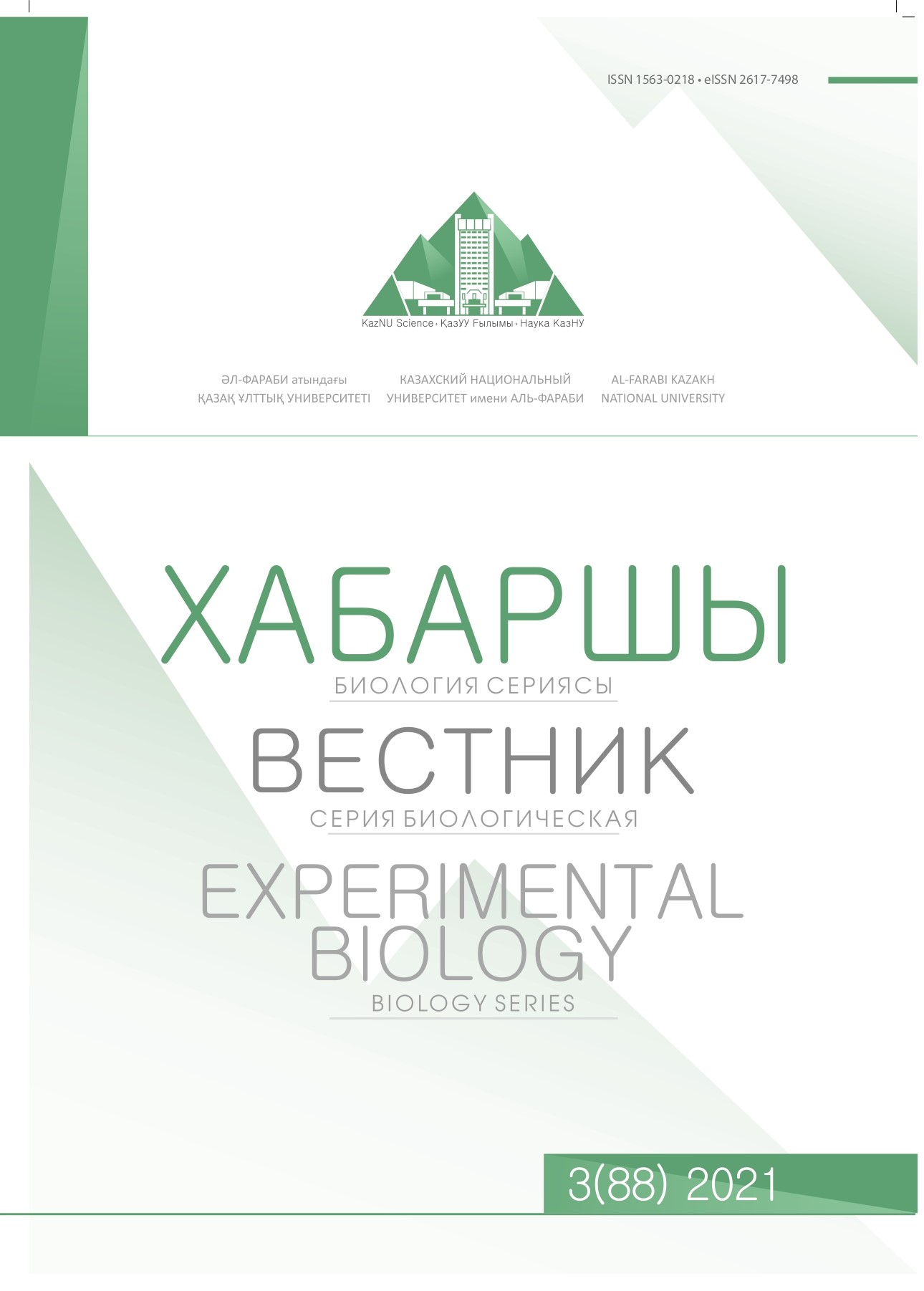AGE COMPOSITION, DENSITY, NUMBER OF THE ENDEMIC SPECIES ARTEMISIA HEPTAPOTAMICA POLJAK
DOI:
https://doi.org/10.26577/eb.2021.v88.i3.01Abstract
The article describes Artemisia heptapotamica Poljak, which is found in the northern Tian Shan region. The habitat, age composition, number, density and distribution range of the endemic species are described. The endemic species are the weakest objects. As their habitat is narrow and often does not withstand the impact of anthropogenic factors, the study shows a lack of vegetative individuals. As a result, the study is prioritized due to the extinction threat. The determination of the number, density, and age composition of coenopopulations was carried out using the methods of A. A. Uranov, O. V. Smirnov, and T. A. Rabotnov. Three main populations were taken for the study - Bartogai reservoir, coenopopulations of The Alatau (population 1), near of Shonji, the Alatau (population 2), villages of Kokpek, the Alatau (population 3).
References
Abad MJ, Bedoya LM, Apaza L, Bermejo P. (2012) The Artemisia L. genus:areview ofbioactiveessentialoils. Molecules,
№17(3), pp. 2542-2566.
Akeroyd J (2002). A rational look at extinction. Plant Talk, Vol. 28. pp. 35-37.
Atazhanova G.A. (2004) Perspektivy ispol’zovaniya v meditsinskoy praktike efirnykh masel rasteniy flory Kazakhstana.
Khimiya i primeneniye prirodnykh i sinteticheskikh biologicheski aktivnykh soyedineniy. – Almaty: Kompleks, pp. 230-235.
Bora, K.S., Sharma, A. (2011) The genus Artemisia: a comprehensive review. Pharm. Biol, №49, pp. 101–109.
Dudchenko L. G., Koz’yakov A. S., Krivenko V. V. (1989) Pryano-aromaticheskiye i pryano-vkusovyye rasteniya. Spravochnik.
Otv. red. K. M. Sytnik. – K.: Naukova dumka, p. 304, 100 000 ekz.
Flora Kazakhstana (1966) Alma – Ata: Nauka, Vol. 9, pp. 76 – 140.7 Flora SSSR (1964). M. Izd – vo AN SSSR, Vol. 26,
p. 78.
Global strategy for plant conservation (2002). Kew, p 62.
Kiyak V. G. (2011) Small plant populations: problems and prospects of research. V. G. Kiyak, Botany and Mycology: problems
and prospects for 2011-2020, pp. 18-20.
Markov M. V. (1962) Obshchaya geobotanika. M. Vysshaya shkola.
Materials of the project workshop: Planning for the conservation of biological diversity at the national level to support the
implementation of The strategic plan of the Convention on biological diversity in the Republic of Kazakhstan for 2010-2011(2012)
. The UNDP project on National biodiversity Strategy and databases. – Almaty.
Mirkin B. M., Rozenberg G. S. (1978) Fitotsenologiya. M, Nauka.
Mukhitdinov N.M. (2011) Geobotany [textbook]. Almaty Daur, pp. 300-344.
Mukhitdinov N.M. (2007) Basics of biogeocenology [textbook]. Almaty, Al-Farabi Kazakh National University, pp. 110-
Mukhitdinov N.M., Almerekova Sh.S., Serbaeva A.D. (2019) Cenopopulation of plants (textbook). Al-Farabi Kazakh National
University, pp. 102-130.
Natsional’naya strategiya i plan deystviy po sokhraneniyu bioraznoobraziya (1999) Kokshetau.
Okhrana okruzhayushchey sredy v Respublike Kazakhstan: statisticheskiy sbornik (2000) Agentstvo Respubliki Kazakhstan
po statistike.
Rabotiov T.A. (1950) Zhiznennyy tsikl mnogoletnikh travyanistykh rasteniy v lugovykh tsenozakh. – Tr. bot. in-ta AN
SSSR, Geobotanika, M.~L. Izd- vo AN SSSR. № 3, Vol 6.
Rabotnov T.A. (1960) Metoda izucheniya semennogo razmnozheniya travyanistaya rasteniy v soobshchestvakh. kn. “Polevaya
geobotanika”, M.-L. Izd-vo AN SSSR. Vol. II.
Rabotnov T.A. (1903) Fitotsenologiya. Ied-vo MU.
Pavlov N.V. (1938) Flora Tsentral’nogo Kazakhstana. M. L. Izd-vo AN SSSR, Vol. 3, pp. 400-428.
Smirnova O.V. (1969) Chislennost’ i vozrastnoy sostav populyatsiy nekotorykh komponentov travyanogo pokrova dubrav.
V kn. “Voprosy morfogeneza tsvetkovykh rasteniy y stroshshya ikh populyatsiy”, M. “Nauka”.
Smirnova O.V. (1960) Ob”yem schetnoy yedinitsy pri izuchenii tsenopopulyatsiy rasteniy razlichnykh biomorf. V kn. “Tsenopopulyatsii
rasteniy (osnovnyye ponyatiya i struktura)”. M. “Nauka”.
Uranov A.A. , Serebryakova T.I. (1976) Plant cenopopulations (basic concepts, structure). M., Science M., Nauka.
Valles, J., McArthur, E.D. (2001) Artemisia systematics and phylogeny: Cytogenetic and molecular insights. In: McArthur,
E. D., Fairbanks, D. J. (comp.) Shrubland Ecosystem Genetics and Biodiversity: Proceedings, 13–15 June 2000, Provo, UT. Proc.
RMRS-P-21. U.S. – Ogden: Department of Agriculture, Forest Service, Rocky Mountain Research Station, pp. 67–74.
Who O. (2003) Traditional Medicine. №134.




